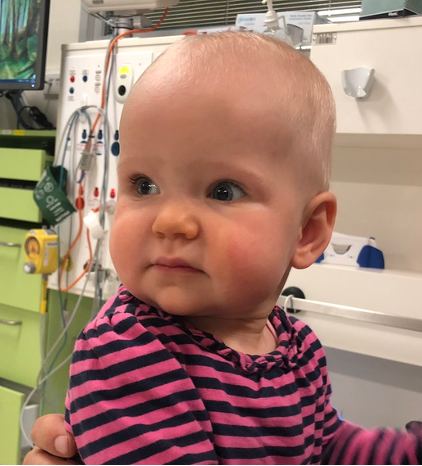14 November 2018 - EAU #10
- Ali Davey

- Apr 8, 2021
- 3 min read
In November we had Isla’s 10th Examination Under Anaesthetic (EUA). We reverted back to the early flight this month so Isla could still have milk on the plane, so it was a long day, but it does make the flight a lot easier. Unfortunately though, this month Isla was the last on the list and she didn’t even go in to theatre until around 3pm. She had been fasting from 7.30am (water allowed until 12noon), but it was a VERY long wait for her and she did VERY well.
Pupils dilated with eyedrops

This month wasn’t all good news. They found two new small tumours in her right eye and cryotherapy (freezing) was applied. The Ophthalmologist also had a lengthy conversation with us about the large tumour in her right eye. They have been keeping a close eye on this for a while as it looked like there was a part of the tumour, which was still alive. So we were aware that there might come a time that we need to do something else to treat that. They mentioned it is likely that we might need to do some Intra-arterial Chemo (IAC) next month and explained a little about what would be involved in that.
After cryotherapy

Obviously we were pretty disappointed with this news, as we had been having a pretty good run for a few months. There had even been talk that we might be able to drop back to EUAs every two months instead of monthly. However, after finding two new tumours and thinking about IAC for the right eye, we will be stuck on monthly trips for a while yet.
__________________________________________________________________________________
Intra-arterial (as opposed to intravenous {systemic} chemo) is more localised. It is a specialised angio procedure where the chemo drug is infused directly into the ophthalmic artery, which feeds the eye. This means Isla will be anesthetised for up to 4+ hours in an angiography suite.
Example of an angio suite

The doctors will make a small incision in her groin to gain access to her femoral artery and a tiny guide wire and catheter will be inserted into the artery. The doctor (a radiologist) will use x-rays to guide this wire up to Isla’s right ophthalmic artery. Once he is happy that he is in the correct artery he will inject a small amount of contrast (xray dye), to confirm he is in the right spot.

Image reprinted courtesy of Dana-Farber/Boston Children's Cancer and Blood Disorders Center.
Xray dye confirming correct location of micro catheter for chemo infusion

Own image.
Once the catheter is in position he will inject the chemo drug directly into the ophthalmic artery. The drug (melphalan) used in this procedure is different to the three previous systemic chemo drugs used and is infused over a 20-30 minute period.
The idea of intra-arterial chemo is to target the treatment as much as possible to the tumour and spare the healthy tissue from any damage. Once the drug is injected into the ophthalmic artery, it is hoped that the majority of the drug will be taken up by the tumour. Chemo drugs cause the most damage to rapidly growing (dividing) cells. It is likely that the tumour cells are some of the most rapidly growing cells in Isla’s eye, so hopefully the tumour is damaged and her healthy eye tissue is spared (as much as possible). Obviously the drug is still going into her bloodstream and may affect other parts of her body, but these effects should be minimal.
The side effects of systemic, or intravenous, chemotherapy are greater because the drug is being more freely circulated through the entire body. Intravenous chemotherapy is injected into a vein, which is returning blood from the body to the heart. This blood is then pumped by the heart ALL over the body. Again it is more damaging to rapidly growing/dividing cells and it should be somewhat targeted to tumours as they will be the most rapidly dividing cells. However, the full dose of chemo drug is being pumped through the entire body before it reaches the tumour cells in her eye, giving it the chance to cause some damage to healthy cells also. This is what causes the side effects related to chemo – hair loss (hair cells are rapidly growing), nausea (gastrointestinal tract cells are rapidly growing), decreased immunity due to drop in white blood cell count (white blood cells are made in bone marrow, bone marrow cells are rapidly growing).
With intra-arterial chemotherapy, once the drug moves on from the eye (in veins back to the heart and then the rest of the body) the dose of chemo drug left in the blood would be very very small. Hopefully resulting in less side effects to the rest of her body.
There are also some good videos on youtube explaining intra arterial chemo for retinoblastoma.
© Alison Davey 2021



Comments